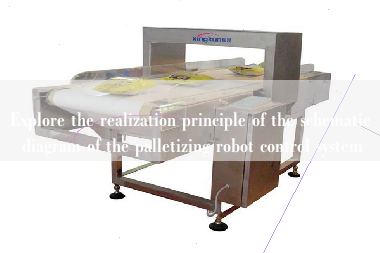Palletizing robot is a robot widely used in logistics, manufacturing and other fields. Its role is to automatically stack goods. The schematic diagram of the control system of the palletizing robot is the key to realizing its automated control. This paper will explore the realization principle of the schematic diagram of the palletizing robot control system.
1. Overview of the schematic diagram of the palletizing robot control system
The schematic diagram of the palletizing robot control system refers to the electrical control system that controls the palletizing robot to carry out automated stacking. The system consists of a main controller, a motion controller, an input and output module, sensors, etc. The main controller is responsible for the control and management of the entire system, the motion controller is responsible for controlling the motion of the robot, the input and output module is responsible for communicating with external devices, and the sensors are responsible for monitoring the motion status of the robot.

2. Realization principle of the schematic diagram of the palletizing robot control system
1. main controller
The main controller is the core of the entire system, and its main function is to uniformly control and manage the robot. The main controller usually uses a single chip microcomputer or an embedded system to control the robot through programming. The functions that the main controller needs to implement include path planning, action control, error detection, etc.
2. motion controller
The motion controller is the key to controlling the motion of the robot. Its main function is to control the motion of each joint of the robot. The motion controller usually uses a servo controller or a step controller to realize the movement of the robot by controlling the speed and direction of the motor. The functions required by the motion controller include speed control, position control, force control, etc.
3. input-output module
The input and output module is the interface for communication between the control system and external equipment. Its main function is to realize data exchange between the control system and sensors, actuators and other equipment. Input and output modules usually use digital signal processors or field buses to communicate with external devices through programming. The functions required by the input and output module include data acquisition, data transmission, data processing, etc.
4. sensor
Sensors are the key to monitoring the motion status of the robot. Their main function is to monitor the robot’s position, speed, force and other parameters in real time. Sensors usually use photoelectric sensors, pressure sensors, force sensors, etc., and control the robot by detecting the motion state of the robot. The functions required by the sensor include data acquisition, data processing, data transmission, etc.
3. Application of schematic diagram of palletizing robot control system
The schematic diagram of the palletizing robot control system is widely used, mainly in logistics, manufacturing and other fields. In the field of logistics, palletizing robots can realize automated stacking of goods and improve logistics efficiency and quality; in the manufacturing field, palletizing robots can realize automated stacking of parts and improve production efficiency and quality.
4. Advantages of the palletizing robot control system schematic
The schematic diagram of the palletizing robot control system has the following advantages:
1. High degree of automation: palletizing robots can realize automated stacking, reduce manual operations, and improve production efficiency and quality.
2. High precision: The palletizing robot can achieve high-precision stacking and ensure the stability and safety of the goods.
3. Strong flexibility: The palletizing robot can be flexibly adjusted according to different stacking requirements and adapt to different production environments.
4. Energy saving and environmental protection: Palletizing robots can realize energy-saving and environmentally friendly production methods and reduce energy consumption and environmental pollution.
V. Conclusion
Through the exploration of this paper, we can understand the realization principle of the palletizing robot control system schematic, as well as its applications and advantages. The application of the schematic diagram of the palletizing robot control system will play an important role in logistics, manufacturing and other fields, bringing more efficient, more accurate and environmentally friendly production methods.
